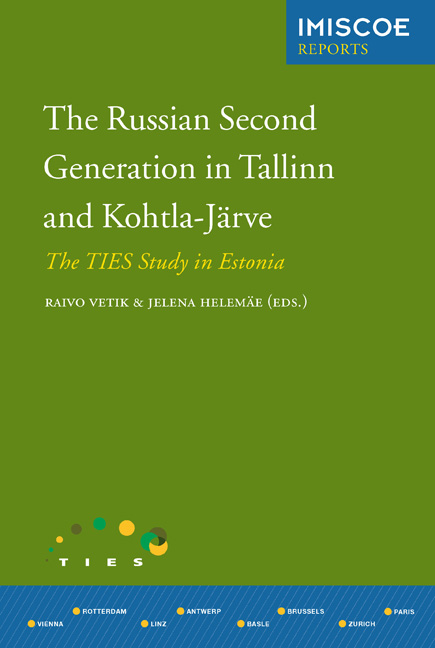Book contents
- Fronmatter
- Contents
- Preface
- List of Tables, Figures and Chapter Appendices
- 1 Introduction
- 2 Migration Patterns
- 3 Integration Policies
- 4 Ethnic Inequalities in Education
- 5 Explaining Different Returns from Human Capital in the labour Market
- 6 Income Inequality
- 7 Housing Conditions Andneighbourhood Satisfaction
- 8 Contact and Crisis in Interethnic Relations
- 9 Gender role Attitudes
- 10 Sense of Belonging to Estonia
- 11 Conclusions
- Appendix
- List of Contributors
- Other IMISCOE Titles
2 - Migration Patterns
Published online by Cambridge University Press: 20 January 2021
- Fronmatter
- Contents
- Preface
- List of Tables, Figures and Chapter Appendices
- 1 Introduction
- 2 Migration Patterns
- 3 Integration Policies
- 4 Ethnic Inequalities in Education
- 5 Explaining Different Returns from Human Capital in the labour Market
- 6 Income Inequality
- 7 Housing Conditions Andneighbourhood Satisfaction
- 8 Contact and Crisis in Interethnic Relations
- 9 Gender role Attitudes
- 10 Sense of Belonging to Estonia
- 11 Conclusions
- Appendix
- List of Contributors
- Other IMISCOE Titles
Summary
Introduction
Russians form the largest minority group in Estonia, constituting 26 per cent of the total population. Although some Russians have lived in the territory for centuries, the majority of today's Russian population came to Estonia during the last 60 years. The current chapter seeks to describe Russian migration patterns to and within Estonia during this period. It also summarises the 2000 population census statistics with regard to several key measures relevant in the context of this volume, as well as offering an overview of the TIES project data basic descriptive statistics.
Migration patterns
During the first independence period (1918-1940), Estonia was a rather ethnically homogeneous country. Estonians constituted about 90 per cent of the population. Among other ethnic groups, the country was home to Russians, Baltic Germans and Swedes. Just before the end of World War II, there was a short period where the proportion of Estonians reached 97 per cent (with other minorities constituting around 3 per cent) (Kulu 1998: 2). Soviet repression, war losses and emigration reduced the Estonian population by a fifth in the 1940s (Hallik 1998: 14). Almost immediately after the occupation of Estonia by Soviet forces in 1944, people of other ethnicities started arriving in the country in large numbers. Immigration was one of the main factors for a growth in the population from 854,000 in 1945 to almost twice that number (1,565,662) in 1989 (Kulu 2001: 2388).
The first years after the end of World War II saw the biggest inflows of immigrants to Estonia – up to 45,000 people a year (ibid.). In the 1950s, the numbers dropped to 35,000-40,000 people a year. By the 1980s, this had diminished by half. Out of the little over one million people who arrived in Estonia between 1946 and 1991, about one third (around 350,000 people) decided to stay (Sakkeus 1991). Russians were the largest ethnic group among immigrants and they still form a substantial minority. In 1959, they already constituted 20.1 per cent of the population, a sharp increase from their share in 1945. By 1989, the percentage grew even further to the point that almost a third of the Estonian population were Russians (SOE 1995). Other noteworthy ethnic groups that became a fixture in the country's population during the same period are Ukrainians (3.1 per cent) and Byelorussians (1.8 per cent).
- Type
- Chapter
- Information
- The Russian Second Generation in Tallinn and Kohtla-JärveThe TIES Study in Estonia, pp. 27 - 38Publisher: Amsterdam University PressPrint publication year: 2012



